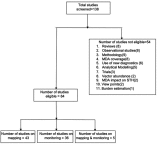Mapping and monitoring for a lymphatic filariasis elimination program: a systematic review
- PMID: 31239804
- PMCID: PMC6554002
- DOI: 10.2147/RRTM.S134186
Mapping and monitoring for a lymphatic filariasis elimination program: a systematic review
Abstract
Lymphatic filariasis (LF) is targeted for elimination by the year 2020. The Global Programme for Elimination of LF (GPELF) aims to achieve elimination by interrupting transmission through annual mass drug administration (MDA) of albendazole with ivermectin or diethylcarbamazine. The program has successfully eliminated the disease in 11 of the 72 endemic countries, putting in enormous efforts on systematic planning and implementation of the strategy. Mapping areas endemic for LF is a pre-requisite for implementing MDA, monitoring and evaluation are the components of programme implementation. This review was undertaken to assess how the mapping and impact monitoring activities have evolved to become more robust over the years and steered the LF elimination programme towards its goal. The findings showed that the WHO recommended mapping strategy aided 17 countries to delimit, plan and implement MDA in only those areas endemic for LF thereby saving resources. Availability of serological tools for detecting infection in humans (antigen/antibody assays) and molecular xenomonitoring (MX) in vectors greatly facilitated programme monitoring and evaluation in endemic countries. Results of this review are discussed on how these existing mapping and monitoring procedures can be used for re-mapping of unsurveyed and uncertain areas to ensure there is no resurgence during post-MDA surveillance. Further the appropriateness of the tests (Microfilaria (Mf)/antigenemia (Ag)/antibody(Ab) surveys in humans or MX of vectors for infection) used currently for post-MDA surveillance and their role in the development of a monitoring and evaluation strategy for the recently WHO recommended triple drug regimen in MDA for accelerated LF elimination are discussed.
Keywords: TAS (transmission-assessment survey); elimination; lymphatic filariasis; mapping; mass drug administration; monitoring; xenomonitoring.
Conflict of interest statement
The authors report no conflicts of interest in this work.
Figures
References
-
- Michael E, Bundy DAP. Global mapping of lymphatic filariasis. Parasitol Today. 1997;13(12):472–476. - PubMed
-
- WHA. WHA50.29 Elimination of lymphatic filariasis as a public health problem. Hbk Res.. 1997. Vol. III (3rd ed.), 1.16.3.3; 7.1.3
-
- WHO. Global programme to elimination lymphatic filariasis. Annual Report on Lymphatic filariasis. 2002; WHO/CDS/CPE/CEE/2002.28.
-
- WHO. Transmission assessment surveys in the global programme to eliminate lymphatic filariasis: WHO position statement. Wkly Epidemiol Rec. 2012;87(48):478–482. - PubMed
-
- WHO. Operational Guidelines for Rapid Mapping of Bancroftian Filariasis in Africa. WHO/CDS/CPE/CEE/2000.9 [press release] Geneva: World Health Organization; 2000.
Publication types
LinkOut - more resources
Full Text Sources


